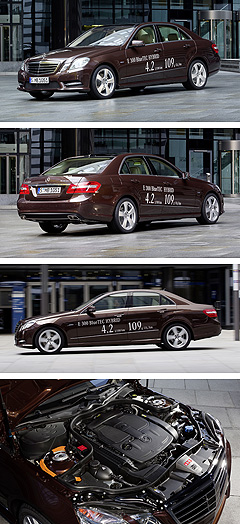Benz still mulling E-Class hybrid
BY HAITHAM RAZAGUI | 3rd Aug 2012

At £39,645 ($A58,740) on the road, the diesel-electric E300 BlueTEC Hybrid is priced closer to upper-spec variants of the V6 diesel E350 CDI than the four-cylinder diesel E250 CDI on which it is based – and this is the sticking point Mercedes-Benz Australia.
Mercedes-Benz Australia senior manager of corporate communications David McCarthy told GoAuto that, as the variant designation suggests, the E300 Hybrid needs to be priced between the E250 and E350.
“We’re still doing the sums on that and working on a business case,” he said.
Mr McCarthy has previously said the E300 Hybrid could end up costing $20,000 more than the E250 CDI, which is priced from $101,005 (plus on-road costs) for the sedan, while the E350 CDI costs $136,485.
The UK premium is equivalent to $A11,749 but considering Australian E-Class pricing is almost two and a half times that of the UK at current exchange rates, that premium could also conceivably reach $20,000.

Based on a fuel price of $1.40 per litre and 15,000 kilometres travelled annually, the E300 Hybrid would save its driver just $252 per year in fuel compared with the E250 CDI, meaning it would take more than 79 years to recoup the $20,000 premium.
In European markets the E300’s low CO2 output rating of 109 grams per kilometre will give it tax advantages, but as the other diesel E-Class variants also have combined fuel consumption below the Australian federal government’s 7.0L/100km efficiency threshold, there would be no such benefits here.
The E300 supplements the E250’s 150kW/500Nm 2.2-litre turbo-diesel engine with a 20kW/250Nm electric motor mounted in the seven-speed automatic transmission and a 19kW lithium-ion battery pack.
However, its extra power and torque does not overcome the extra weight of batteries and electrical components to better the E250’s 7.5-second 0-100km/h time.
Benz says the E300 can travel for a short distance on electricity alone and, like the petrol-electric hybrid BMW 3, 5 and 7 Series – all of which are coming to Australia within months – can disengage the internal combustion engine while coasting.
The E300’s battery packs and control units are mounted in a way that does not reduce the car’s load capacity and the electric motor’s integration adds just 65mm to the length of the transmission.
Mercedes unveiled the E300 Hybrid at the Detroit motor show in January alongside the V6 petrol-based E400 Hybrid, which borrows its drivetrain from the larger S400 Hybrid.
BMW’s 5 Series ActiveHybrid sedan links a 40kW/210Nm electric motor with a 225kW/400Nm 3.0-litre turbocharged petrol straight-six to deliver a combined output of 250kW/450Nm.
By comparison, the Lexus GS450h runs a 3.5-litre naturally aspirated V6 to provide a combined output of 252kW/345Nm and matches the BMW’s 0-100km/h sprint time while being 1.0L/100km more efficient at 6.3L/100km.
Audi’s A6 hybrid combines a 155kW/350Nm petrol engine with an electric motor developing an additional 40kW and 210Nm to feed a combined 188kW and 480Nm to the front wheels, resulting in 0-100km/h in 7.3 seconds and 6.2L/100km.